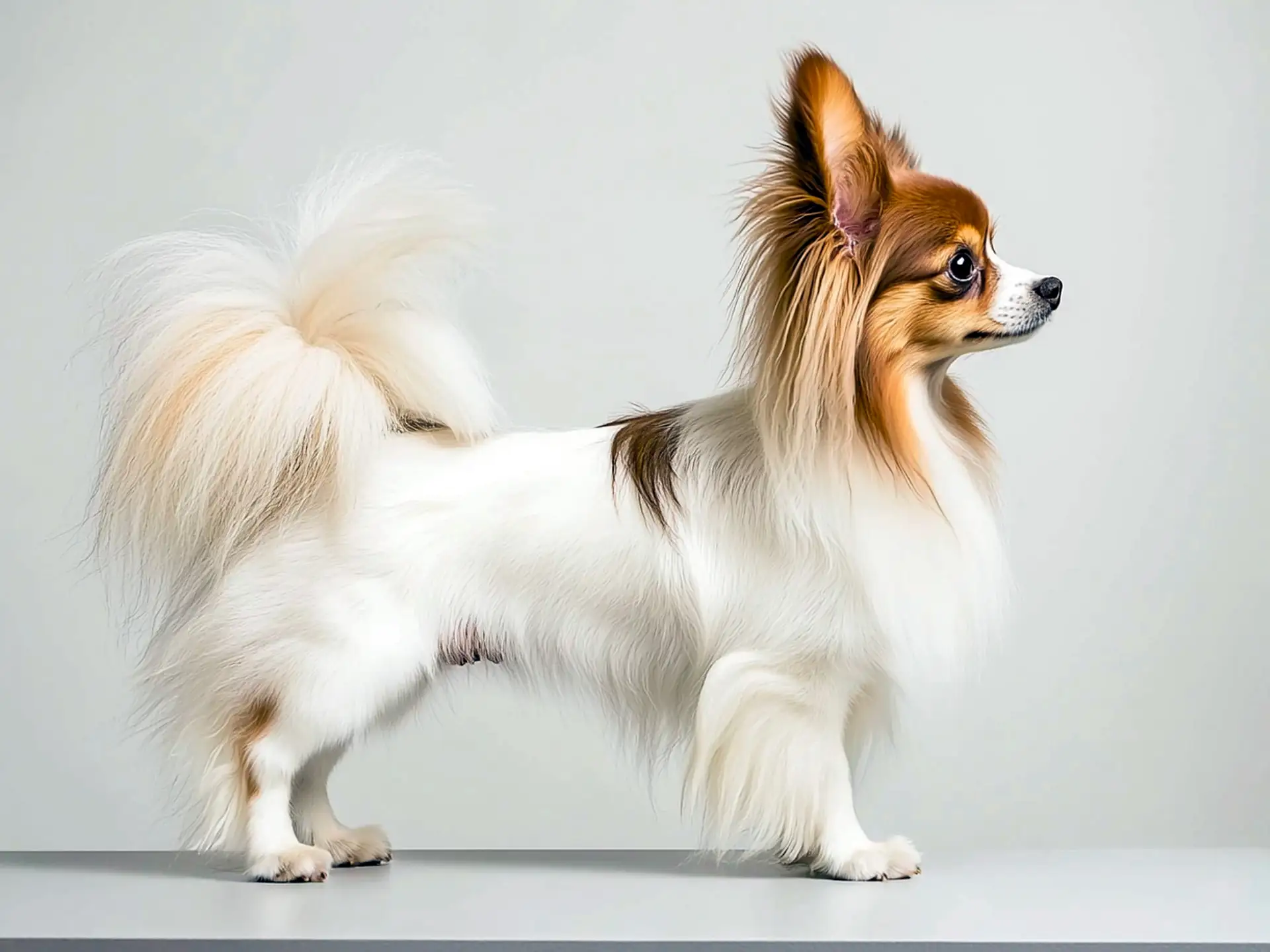Papillon Dog Breed Info & Overview
Tiny, elegant, and strikingly poised, the Papillon is a captivating toy dog with ears resembling fluttering butterfly wings. Bred for companionship, this petite friend is known for its happy-go-lucky personality and keen intelligence. Whether you’re lounging around at home or heading out to show off your adorable buddy, the Papillon effortlessly turns heads wherever it goes.
Characteristics
Pictures
Breed History
Although its name is French for “butterfly,” the Papillon’s earliest roots trace back to Belgium and other parts of Europe. Over centuries, royal courts favored this delicate toy spaniel for its refined beauty and affectionate nature. Wealthy nobles would commission famous painters—like Rubens—to immortalize them, ensuring the breed’s iconic ears and sweet expressions were etched into history.
Popularity soared in France during the reigns of Marie Antoinette and King Louis XIV, both said to have owned Papillons. Their elegant appearance made them prized lapdogs for high society. Through careful selective breeding, dedicated enthusiasts further refined the Papillon’s signature plumed tail, erect ears, and petite stature, all while preserving its sunny disposition.
Today, the Papillon’s refined lineage is evident in its spirited personality and distinctive silhouette. Major kennel clubs worldwide recognize this breed, reinforcing its reputation as a beloved companion. Despite centuries passing, those iconic ears remain a charming nod to a time when these pint-sized pups were truly the companions of the rich and regal.
Temperament, Personality
Brimming with curiosity, this lively breed is always eager to explore every corner of the house. While they love a good nap in your lap, Papillons are surprisingly active and appreciate interactive toys or puzzle games. They’re well-known for being perky greeters, happy to welcome family members and guests with a bright, inquisitive look.
Confidence is part of this dog’s charm. Despite their small stature, they often approach bigger dogs or new friends without hesitation—so early socialization is key. Their friendly demeanor usually extends to children, but supervision is wise to ensure no accidental bumps happen. These pups thrive on positive attention and can become your shadow around the home.
Sensitive yet outgoing, Papillons are quick to pick up on household moods, offering comfort or playfulness at just the right time. Though they relish affection, they’re not typically needy. Their balanced nature makes them an excellent option for those seeking a tiny companion with a big personality, someone who can keep up with everyday fun and offer unwavering devotion.
Physical Characteristics
At first glance, this breed’s standout feature is its large, erect ears adorned with fringing that gives a butterfly-like appearance. The expressive eyes, dark and luminous, reflect endless curiosity. Coupled with a fine-boned body, Papillons maintain an air of delicate elegance—though don’t be fooled, they can be quite sturdier than they look when it’s time to frolic.
Their coat is silky, single-layered, and lies close to the body, with feathering on the ears, chest, and tail. Most are parti-colored (white with patches of color) or white and sable. The breed’s long tail, arched over the back, adds an extra dash of grace. Thanks to selective breeding, their size remains consistently on the smaller side.
While they might exude daintiness, these dogs are built to move with ease and surprising agility. The proud head carriage and poised stance show a sense of self-assuredness. Because of their tiny frame, it’s essential for owners to be mindful of potential injuries, making gentle handling and proper playtime crucial to keep these spirited pups safe and sound.
Health Issues
Common concerns for this breed include patellar luxation—a knee issue where the kneecap slips out of place—and dental problems due to their smaller jaw. Regular check-ups can help detect these conditions early. Additionally, they can be prone to fontanel (soft spot on the skull) when very young, so careful handling during puppyhood is crucial.
As with many toy breeds, Papillons may also experience low blood sugar (hypoglycemia) if they skip meals, particularly during their early months. Close monitoring of energy levels helps you catch any issues before they escalate. A balanced, high-quality diet, along with routine veterinary visits, forms the foundation of preventive care.
Because they’re active and engaged dogs, providing mental stimulation also supports overall health. Consider puzzle toys or short training sessions to keep their minds sharp. If you notice any limping, changes in eating habits, or unusual behavior, consult your vet promptly. Early detection of potential problems typically leads to better outcomes and a longer, happier life.
Grooming Needs
While their silky coat may look daunting, it’s relatively simple to maintain. Brushing a few times a week keeps tangles at bay, especially around the ears and behind the legs where knots can form. Because the hair is fine, using a soft-bristle brush or a comb designed for delicate coats is best.
Monthly baths usually suffice—unless your Papillon is an adventurous sort who finds every mud puddle. Pay special attention to the feathering on the ears and tail, as these luxurious fringes can trap debris. Dry them gently with a towel and a low-heat setting if using a blow dryer, ensuring you don’t damage their sensitive skin.
Don’t forget routine ear cleaning with a vet-approved solution, as their wide ears can pick up dust and dirt. Trimming nails every couple of weeks helps maintain proper foot structure. Regular dental care is also essential; aim for daily brushing or at least several times a week. By keeping a consistent grooming schedule, you’ll have one radiant little companion.
Exercise Requirements
Despite their petite build, Papillons enjoy bursts of activity. A brisk daily walk and some indoor play can work wonders for their energy levels. Because they’re so clever, mental stimulation—like hide-and-seek or treat-dispensing toys—goes hand in hand with physical exercise, keeping them both entertained and well-rounded.
They excel in canine sports such as agility and rally, where their quick reflexes and light frame give them an edge. If you’re inclined, setting up a small obstacle course in your living room or backyard can be a fun way to bond. Just remember to keep jumps low and surfaces secure to protect those nimble joints.
For owners living in apartments, short bursts of play inside plus a couple of strolls each day are typically enough. They’re also a great choice for seniors who want an enthusiastic walking partner without overwhelming physical demands. Keep an eye on their stamina—if they start panting heavily or seem tired, it’s time to slow down and recharge.
Training Tips
Quick to learn and eager to please, these dogs respond brilliantly to positive reinforcement. Using treats, praise, or gentle petting helps them associate training sessions with fun. Because the breed is quite perceptive, they’ll easily pick up on frustration—so staying upbeat and patient pays off, especially when teaching basic commands like “sit” or “stay.”
Housebreaking can be relatively smooth if you establish a regular schedule. Due to their small bladder, frequent potty breaks at the start are crucial. Crate training also offers a cozy, safe environment that fosters good habits. While they’re bright, Papillons can be sensitive to harsh scolding, so a calm, reassuring tone typically yields the best results.
These pups excel in trick training, from rolling over to dancing on hind legs. Keep sessions short, around 5–10 minutes, to maintain focus. Early socialization helps them adapt to meeting strangers, children, or other animals without nervousness. With consistent guidance, you’ll have not just a well-mannered dog but a joyful companion who loves showing off new skills.
Nutrition, Diet
Papillons have fast metabolisms, so they need a high-quality kibble specifically formulated for toy breeds. Aim for a brand with a protein content around 25–30% and moderate fat levels to sustain their energy. Choose small, bite-sized pieces that are easier for them to chew, and avoid fillers like corn or soy, which can irritate sensitive stomachs.
A typical adult weighing about 7 pounds (3 kg) might eat roughly 1/2 cup of food per day, divided into two meals. For puppies, more frequent meals—three or four times daily—help maintain stable blood sugar levels. If your dog is especially active, adjust portions to accommodate calorie burn; if they’re more of a couch potato, watch for overfeeding.
Supplement with healthy treats like small pieces of lean meat or crunchy vegetables (carrots, cucumber) as occasional rewards. Avoid giving them large or hard chews that could strain their jaw. Regular weight checks ensure they stay trim, preventing added stress on joints. Consult your vet for specific portion sizes or to address any unique dietary sensitivities.
Adoption, Breeders
If you’re set on a Papillon, begin by researching breed-specific rescues, as these organizations often have older dogs or pups in need of a second chance. Websites such as PapHaven Rescue frequently list available dogs with detailed background info, helping you find the perfect match. Meeting the dog in person before finalizing an adoption is always wise.
For those who prefer a puppy from a breeder, prioritize ethical sources registered with reputable kennel clubs. Seek out health clearances for knees and hearts, plus references from past buyers. The Papillon Club of America is an excellent resource for breeder referrals, offering guidelines on selecting someone committed to the breed’s well-being.
Avoid puppy mills or impulse buys from pet stores. Responsible breeders welcome questions, provide clean living conditions, and introduce you to the litter’s parents. If adopting, ask about any known medical history or behavioral quirks. Either path you choose, taking time to research ensures you’ll bring home a well-adjusted companion who’s ready for a lifetime of love.
Family Pet?
Many families fall head-over-heels for this cheerful pup. They have a knack for brightening moods and joining in on group activities. Young children should be shown how to handle them gently—think “butterfly dog” reminding us of how delicate they can be. With patient, supervised interactions, Papillons and kids often form a mutual admiration society of giggles and tail wags.
Their moderate energy level means they’ll happily play fetch but also contentedly curl up on the couch during movie night. Because they thrive on attention, they’ll love being involved in everyday tasks. Be mindful of loud or chaotic households, though—some dogs can become anxious if overwhelmed by constant commotion, so a cozy retreat spot helps them decompress.
Overall, they adapt well to various family structures, whether it’s a bustling home with multiple kids or a quieter environment shared with seniors. Social and fun-loving, they typically get along with other pets when introduced properly. If you’re searching for a friendly sidekick that can keep pace with diverse family schedules, this toy breed fits the bill nicely.
Right For You?
If you want a dog that’s small enough for apartment living yet spunky enough for an afternoon sprint, the Papillon might be your dream companion. Their moderate grooming needs suit owners willing to brush a few times a week. They’ll flourish in a home where mental stimulation—like puzzle toys—supplements short daily walks.
Families who travel or stay active will appreciate how portable Papillons are. Their size makes them less intimidating for first-time dog parents, too. However, if you’re rarely home or if you prefer a low-energy pet that’s content alone for long stretches, this breed may not be the best match. Ultimately, they thrive on companionship and consistent engagement.
Before adding one to your life, consider whether you can provide the attention and playtime this inquisitive dog craves. They relish being part of your day-to-day events, whether it’s a quick errand or a leisurely drive. While Papillons do well with various lifestyles, owners willing to offer gentle care and dedicated bonding moments truly bring out the best in them.
Conclusion
Endearing, inquisitive, and surprisingly agile, Papillons capture hearts with their butterfly-like ears and lively spirits. They’re a good match for anyone looking for a sociable companion that enjoys both active play and cuddling on the couch. While small in stature, their personalities are anything but tiny. If you’re ready for a friendly pup that thrives on togetherness, this delightful breed could be your perfect partner.
FAQs
-
Why do Papillons have such large ears compared to their body size?
The Papillon’s oversized ears serve a functional purpose beyond aesthetics. Their large surface area enhances hearing sensitivity, a trait inherited from their spaniel ancestors. Additionally, their erect or butterfly-shaped ears help with thermoregulation by dissipating heat in warmer climates.
-
Are there different ear types in Papillons?
Yes, Papillons can have either erect or drop ears. The erect-eared version is the most recognized, but the Phalène (a variation of the breed) has ears that fold downward. Both types exist within the same breed, and Phalènes are just as purebred as their upright-eared counterparts.
-
Why do Papillons have such a long lifespan compared to other toy breeds?
Papillons often live 13–17 years due to their low genetic predisposition to severe health issues. Unlike many small breeds prone to breathing difficulties or fragile bones, Papillons have a robust build, a strong heart, and fewer congenital conditions affecting longevity.
-
Do Papillons have hunting instincts despite being companion dogs?
Yes, Papillons retain a strong prey drive from their spaniel heritage. They may chase insects, small rodents, or even birds in the yard. Their keen eyesight and quick reflexes make them excellent at catching small moving objects, though they are not used for hunting today.
-
Why do Papillons often walk with a prancing or bouncy gait?
Papillons have a distinct springy gait due to their strong hindquarters and fine bone structure. This movement style is a hallmark of the breed and is commonly seen in show rings. Their light, graceful steps make them appear elegant and poised, even at high speeds.
Breed Ratings
Papillons are extremely bright, quickly mastering commands and tasks with little repetition.
They love a good romp or chase game but also appreciate their downtime.
Moderate energy suits a mix of short walks and indoor play sessions well.
The fine, silky coat sheds moderately, so weekly brushing keeps it under control.
They may chase small critters briefly, but prey drive isn’t typically high.
A couple of brushings per week and a bath now and then are generally enough.
With patience and treats, they pick up new skills almost effortlessly.
Extended solitude can lead to boredom or anxiety, so they need human interaction.
They’ll bark to alert but aren’t usually excessive without reason.
Drooling is minimal, making them a clean little companion.
They’re social and often get along with other pups if properly introduced.
Generally healthy, but watch for knee issues and monitor blood sugar levels.

















